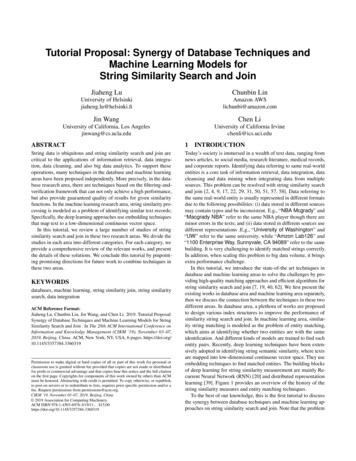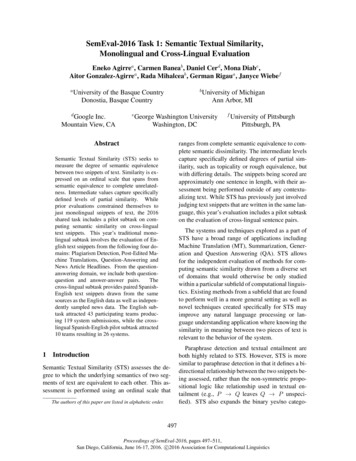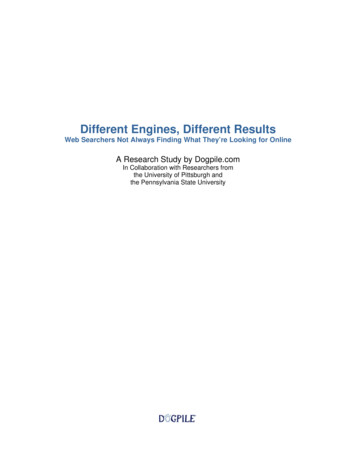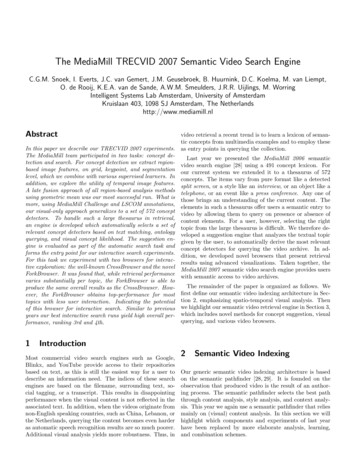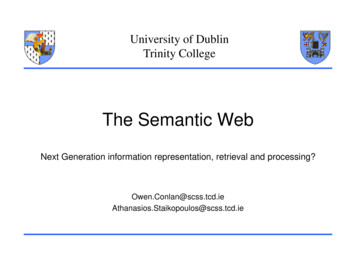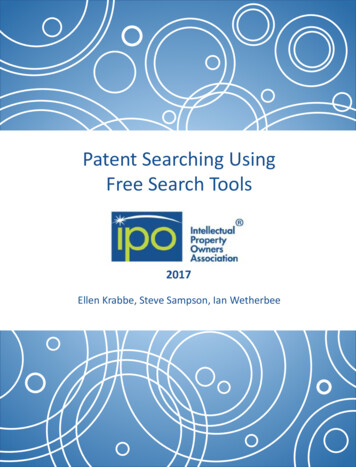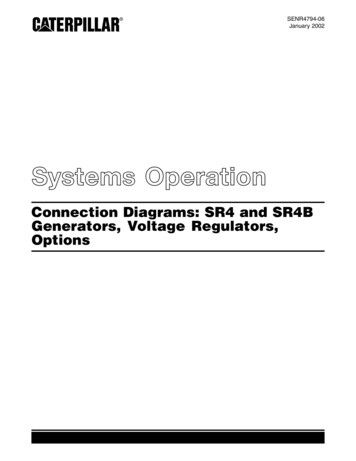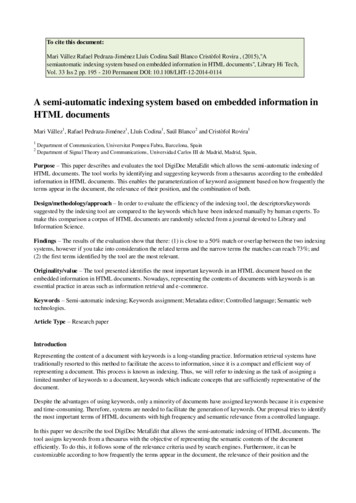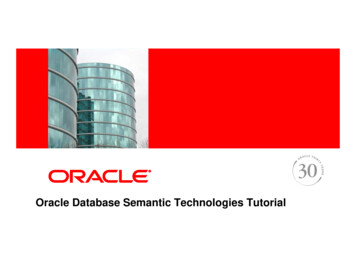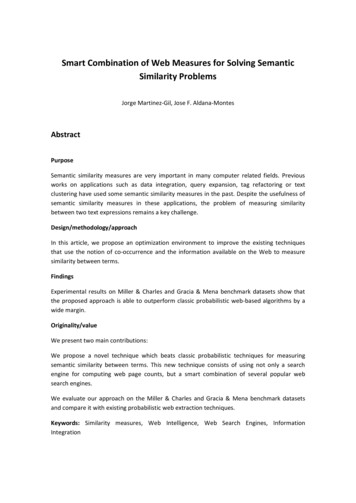
Transcription
Smart Combination of Web Measures for Solving SemanticSimilarity ProblemsJorge Martinez-Gil, Jose F. Aldana-MontesAbstractPurposeSemantic similarity measures are very important in many computer related fields. Previousworks on applications such as data integration, query expansion, tag refactoring or textclustering have used some semantic similarity measures in the past. Despite the usefulness ofsemantic similarity measures in these applications, the problem of measuring similaritybetween two text expressions remains a key challenge.Design/methodology/approachIn this article, we propose an optimization environment to improve the existing techniquesthat use the notion of co-occurrence and the information available on the Web to measuresimilarity between terms.FindingsExperimental results on Miller & Charles and Gracia & Mena benchmark datasets show thatthe proposed approach is able to outperform classic probabilistic web-based algorithms by awide margin.Originality/valueWe present two main contributions:We propose a novel technique which beats classic probabilistic techniques for measuringsemantic similarity between terms. This new technique consists of using not only a searchengine for computing web page counts, but a smart combination of several popular websearch engines.We evaluate our approach on the Miller & Charles and Gracia & Mena benchmark datasetsand compare it with existing probabilistic web extraction techniques.Keywords: Similarity measures, Web Intelligence, Web Search Engines, InformationIntegration
IntroductionThe study of semantic similarity between terms is an important part of a lot of computerrelated fields (Zhu et al., 2010). Semantic similarity between terms changes over time andacross domains. The traditional approach to solve this problem has consisted of using manuallycompiled taxonomies such as WordNet (Budanitsky et al., 2006). The problem is that a lot ofterms (proper nouns, brands, acronyms, new words, and so on) are not covered bydictionaries; therefore, similarity measures that are based on dictionaries cannot be useddirectly in these tasks (Bollegala et al., 2007). However, we think that the great advances inweb research have provided new opportunities for developing more accurate solutions.In fact, with the increase of larger and larger collections of data resources on the World WideWeb (WWW), the study of web extraction techniques has become one of the most activeareas for researchers. We consider that techniques of this kind are very useful for solvingproblems related to semantic similarity because new expressions are constantly being createdand also new senses are assigned to existing expressions (Bollegala et al., 2007). Manuallymaintaining databases to capture these new expressions and meanings is very difficult, but itis, in general, possible to find all of these new expressions in the WWW (Yadav, 2010).Therefore, our approach considers that the chaotic and exponential growth of the WWW is theproblem, but also the solution. In fact, we are interested in three characteristics of the Web: It is one of the biggest and most heterogeneous databases in the world. And possiblythe most valuable source of general knowledge. Therefore, the Web fulfills theproperties of Domain Independence, Universality and Maximum Coverage proposed in(Gracia & Mena, 2008).It is close to human language, and therefore can help to address problems related tonatural language processing.It provides mechanisms to separate relevant from non-relevant information or ratherthe search engines do. We will use these search engines to our benefit.One of the most outstanding works in this field is the definition of the Normalized GoogleDistance (NGD) (Cilibrasi & Vitanyi, 2007). This distance is a measure of semantic relatednessderived from the number of hits returned by the Google search engine for a given (set of)keyword(s). The idea behind this measure is that keywords with similar meanings from anatural language point of view tend to be close according to the Google distance, while wordswith dissimilar meanings tend to be farther apart. In fact, Cilibrasi and Vitanayi (2007) state:“We present a new theory of similarity between words and phrases based on informationdistance and Kolmogorov complexity. To fix thoughts, we used the World Wide Web (WWW)as the database, and Google as the search engine. The method is also applicable to othersearch engines and databases''. Our work is about those web search engines; more specifically,we are going to use not only Google, but a selected set of the most popular ones.In this work, we are going to mine the Web, using web search engines to determine the degreeof semantic similarity between terms. It should be taken into account that under nocircumstances data from experiments presented in this work can be considered as a
demonstration that one particular web search engine is better than another or that theinformation it provides is more accurate. In fact, we show that the best results are obtainedwhen weighting all of them in a smart way. Therefore, the main contributions of this work are: We propose a novel technique which beats classic probabilistic techniques formeasuring semantic similarity between terms. This new technique consists of usingnot only a search engine for computing web page counts, but a smart combination ofseveral popular web search engines. The smart combination is obtained using an elitistgenetic algorithm that is able to adjust the weights of the combination formula in anefficient manner.We evaluate our approach on the Miller & Charles (Miller & Charles, 1998) and Gracia& Mena (Gracia & Mena, 2008) benchmark datasets and compare it with existingprobabilistic web extraction techniques.The rest of this work is organized as follows: Section 2 describes several use cases where ourwork can be helpful. Section 3 describes the preliminary technical definitions that arenecessary to understand our proposal. Section 4 presents our contribution which consists of anoptimization schema for a weighted combination of popular web search engines. Section 5shows the data that we have obtained from an empirical evaluation of our approach. Section 6discusses the related works and finally, Section 7 presents the conclusions and future lines ofresearch.Use CasesIdentifying semantic similarities between terms is not only an indicator of mastery of alanguage, but a key aspect in a lot of computer-related fields too. It should be taken intoaccount that semantic similarity measures can help computers to distinguish one object fromanother, group them based on the similarity, classify a new object into the group, predict thebehavior of the new object or simplify all the data into reasonable relationships. There are alot of disciplines where we can get benefit from these capabilities. For example, dataintegration, query expansion, tag refactoring or text clustering. Now, we are going to explainwhy.Data integrationNowadays data from a large number of web pages are collected in order to provide newservices. In such cases, extraction is only part of the process. The other part is the integrationof the extracted data to produce a coherent database because different sites typically usedifferent data formats (Halevy et al., 2006). Integration means to match columns in differentdata tables that contain the same kind of information (e.g., product names) and to matchvalues that are semantically equivalent but represented differently in other sites (e.g., “cars”and “automobiles”). Unfortunately, only limited integration research has been done so far inthis field.Query ExpansionQuery expansion is the process of reformulating queries in order to improve retrievalperformance in information retrieval tasks (Vechtomova & Karamuftuoglu, 2007). In thecontext of web search engines, query expansion involves evaluating what terms were typed
into the search query area and expanding the search query to match additional web pages.Query expansion involves techniques such as finding synonyms of words (and searching for thesynonyms as well) or fixing spelling errors and automatically searching for the corrected formor suggesting it in the results, for example.Web search engines invoke query expansion to increase the quality of user search results. It isassumed that users do not always formulate search queries using the most appropriate terms.Appropriateness in this case may be because the system does not contain the terms typed bythe user.Tag refactoringNowadays the popularity of tags in websites is increased notably, but its generation iscriticized because its lack of control causes it to be more likely to produce inconsistent andredundant results. It is well known that if tags are freely chosen (instead of taken from a givenset of terms), synonyms (multiple tags for the same meaning), normalization of words andeven, heterogeneity of users are likely to arise, lowering the efficiency of content indexing andsearching contents (Urdiales-Nieto et al., 2009) . Tag refactoring (also known as tag cleaningor tag gardening) is very important in order to avoid redundancies when labeling resources inthe WWW.Text clusteringText clustering is closely related to the concept of data clustering. Text clustering is a morespecific technique for unsupervised document organization, automatic topic extraction andfast information retrieval and filtering (Song et al., 2009).A web search engine often returns many web pages in response to a broad query, making itdifficult for users to browse or to identify relevant information. Clustering methods can beused to automatically group the retrieved web pages into a list of logical categories.Text clustering involves the use of descriptors and descriptor extraction. Descriptors are sets ofwords that describe the contents within the cluster. Examples of text clustering include webdocument clustering for search users.Technical PreliminariesGiven two terms a and b, the problem which we are addressing consists of trying to measurethe semantic similarity between them. Semantic similarity is a concept that extends beyondsynonymy and is often called semantic relatedness in literature. According to Bollegala et al.(2007); a certain degree of semantic similarity can be observed not only between synonyms(e.g. lift and elevator), but also between meronyms (e.g. car and wheel), hyponyms (leopardand cat), related words (e.g. blood and hospital) as well as between antonyms (e.g. day andnight) (Bollegala et al., 2007). In this work, we focus on optimizing web extraction techniquesthat try to measure the degree of synonymy between two given terms using the informationavailable on the WWW.
These are the definitions for the concepts that we are going to use:Definition 1 (Similarity measure). A similarity measure sm is a function sm : µ1 x µ2 R thatassociates the similarity of two input terms µ1 and µ2 to a similarity score sc є R in the range [0,1] which states the confidence for the relation µ1 and µ2 to be true .In this way, a similarity score of 0 stands for complete inequality of the input terms and 1 forthe semantic equivalence of µ1 and µ2.Definition 2 (Hit). Hit (also known as page count) is an item found by a search engine to matchspecified search conditions. More formally, we can define a hit as the function hit: expr Nwhich associates an expression to a natural number which ascertains the popularity of expr inthe subset of the WWW indexed by the search engine.A value of 0 stands for no popularity and the bigger the value, the bigger its associatedpopularity. Moreover, we want to remark that the function hit has many possibleimplementations. In fact, every web search engine implements it a different way.Example 1. (Similarity measures based on web hits). If we look at the literature, we can find alot of similarity measures. For example, measures based on hits which are a kind of similaritymeasure which are calculated based on the co-occurrence (Dagan et al., 2009) of the terms inthe WWW, thus, the number of hits for each individual term to be compared and theirconjunction. Some of the most popular measures of this kind are: Pointwise MutualInformation (PMI) (Turney, 2001), Dice, Overlap Coefficient or Jaccard (Manning & Schütze,1999), to cite some of them. When these measures are used on the Web, it is necessary to addthe prefix Web-; WebPMI, WebDice, and so on. All of them are considered probabilisticbecause given a web page containing one of the terms a or b, these measures try to computethe probability of that web page also containing the other term. These are their correspondingformulas:𝑊𝑒𝑏𝑃𝑀𝐼 (𝑎, 𝑏) 𝑊𝑒𝑏𝐷𝑖𝑐𝑒 𝑎, 𝑏 𝑊𝑒𝑏𝑂𝑣𝑒𝑟𝑙𝑎𝑝 𝑎, 𝑏 𝑊𝑒𝑏𝐽𝑎𝑐𝑐𝑎𝑟𝑑 𝑎, 𝑏 𝑝(𝑎, 𝑏)𝑝 𝑎 · 𝑝(𝑏)2 · 𝑝 𝑎, 𝑏𝑝 𝑎 𝑝 𝑏𝑝 𝑎, 𝑏min 𝑝 𝑎 , 𝑝 𝑏𝑝 𝑎, 𝑏𝑝 𝑎 𝑝 𝑏 𝑝 a, 𝑏On the WWW, probabilities of term co-occurrence can be expressed by hits. In fact, theseformulas are measures for the probability of co-occurrence of the terms a and b (Cilibrasi &Vitanyi, 2007). The probability of a specific term is given by the number of hits returned whena given search engine is presented with this search term divided by the overall number of web
pages possibly returned. The joint probability p(a, b) is the number of hits returned by a websearch engine, containing both the search term a and the search term b divided by the overallnumber of web pages possibly returned. Estimation about the number of web pages possiblyreturned by a search engine has been studied in the past (Bar-Yossef & Gurevich, 2006). In thiswork, we set the overall number of web pages as 1010 according to the number of indexedpages reported in (Bollegala et al., 2007).Despite its simplicity, using hits as a measure of co-occurrence of two terms presents severaladvantages. It is surprisingly good at recognizing synonyms because it seems to be empiricallysupported that synonyms often appear together in web pages (Cilibrasi & Vitanyi, 2007).Moreover, if the search terms never occur (or almost never) together on the same web pages,but do occur separately, this kind of measure will present very low similarity values.ContributionTraditionally web extraction techniques which are based on the notion of web hits have used agiven web search engine (frequently Google) in order to collect the necessary information fortheir purposes. We thought that there was no compelling reason for considering Google themost appropriate web search engine in order to collect information and we began to use othersearch engines.When we collected and processed the data from a wide variety of search engines, we saw thatGoogle was the best source. However, we discovered that the average mean of the results wasbetter than the results from Google. So we understood that maybe an optimized combinationof those search engines could be even better than the average means. Based on this, wedesigned an experiment in order to test our hypothesis.Figure 1 shows the solution proposed for the computation of the optimized web extractionapproaches. The key of the architecture is an elitist genetic algorithm (i.e. an algorithm whichselects the better individuals in each iteration), with a small mutation rate which generates avector of numerical weights and associates them to their corresponding web search engine.The final solution can be expressed in the form of a numeric weight vector. It should be takeninto account that the output of this architecture is a function that tries to simulate thebehavior of the (group of) human(s) who solve the input benchmark dataset.For the implementation of the function hit, we have chosen the following search engines fromamong the most popular in the Alexa ranking (Alexa, 2010): Google, Yahoo!, Altavista, Bing,and Ask. It should be taken into account that our approach does not include the automaticselection of appropriate web search engines because it assumes that all of them are offeredinitially, and those which may be associated with a weight of 0 will be automaticallydeselected.The vector of numerical weights is encoded in binary format in each of the genes belonging tothe domain of the genetic algorithm. For example, a vector of 20 bits can represent 1 weight of20 bits, 2 weights of 10 bits, 4 weights of 5 bits, or 5 weights of 4 bits. It is necessary toimplement a function to convert each binary weight into decimal format before to calculatethe fitness for the weight vector. The number of decimal possibilities for each weight is 2bits,for example, in case of choosing a vector of 5 weights of 4 bits, it is possible to represent 5
weights with 24 16 different values. These different values can range from 0 to 15, from 8 to 7, from 0 to 1 (where ticks have double precision) and so on. This depends of theimplementation for the conversion from binary format into decimal format.The comparison between the benchmark datasets and our results is made using the Pearson’sCorrelation Coefficient, which is a statistical measure which allows comparing two matrices ofnumeric values. Therefore the results can be in the interval [-1, 1], where -1 represents theworst case (totally different values) and 1 represents the best case (totally equivalent values).Figure 1. Solution proposed for the computation of the semantic similarity measure. An elitist genetic algorithmgenerates a vector of numerical weights. The final solution can be expressed in the form of a numeric weightvector.Our approach is efficient and scalable because it only processes the snippets (no downloadingof web pages is necessary) for the result pages from the web search engines. On the otherhand, scalability is given by our genetic algorithm which allows us to expand the set of websearch engines without causing any kind of technical problem. This is would not be possible ifwe would use a brute force strategy, for example.
It should be taken into account that problems related to the speed of the process, and moreimportantly, to the restrictions on the maximum number of allowed queries per engine, aresolved by means of a preliminary phase which loads the results retrieved from the searchengines into appropriate data structures. We consider that this information is valid for a periodof 7 days, because the content indexed by the search engines growths dynamically.EvaluationIn this section, we are going to show an evaluation of our approach. The section is divided in a)a preliminary study to choose the appropriate parameters for configuring the optimizationenvironment, b) the empirical data that we have collected from the experiments, c) a study onthe quality of the optimized function, d) the effect of the operators on the final result andfinally, e) the information necessary to repeat the experiments.Preliminary studyWe are going to do a preliminary study of the configuration parameters for the environment.----For the number of genes per chromosome we have selected such values as 5, 10 and20. A study using a t-Test distribution has shown us that that the differences betweensamples obtained by means of these parameters are not statistically significant.Therefore, we have selected 20 genes per chromosome.For the number of individuals in the population, we have selected such values as 20, 50and 100. Again, a t-Test statistical distribution has shown that the differences betweenthese samples are not statistically significant. We have selected a population of 100individuals.Related to crossover and mutation fraction, we have chosen a high value for thecrossover between genes and, a small percentage for mutations, because we wish aclassical configuration for the genetic algorithm.Related to the combination formula, our preliminary study has shown us that theweighted sum is better that the weighted product and the weighted square.After ten independent executions, we noticed that the genetic algorithm did not improve theresults beyond the 200th generation, so we have set a limit of 200 generations for thealgorithm. The final results are computed by means of the average mean from these 10generations. We are going to evaluate our approach using the Miller & Charles benchmarkdataset which is a dataset of term pairs rated by a group of 38 human beings (Miller & Charles,1998). Term pairs are rated on a scale from 0 (no similarity) to 4 (complete similarity). Miller &Charles dataset benchmark is a subset of Rubenstein & Goodenough original benchmarkdataset of 65 term pairs (Rubenstein & Goodenough, 1965). Although Miller & Charlesexperiment was carried out many years later than Rubenstein & Goodenough, Bollegala et al.(1965) state that two sets of ratings are highly correlated (Bollegala et al., 2007). Therefore,Miller & Charles ratings can be considered as a good benchmark dataset to evaluate solutionsthat involve semantic similarity measures.ResultsIn this subsection we are going to present the empirical results that we have obtained fromour experiments. It should be taken into account that all figures, except those for the Miller &
Charles ratings, are normalized into values in [0, 1] range for ease of comparison. Pearson'scorrelation coefficient is invariant against a linear transformation (Bollegala et al., 2007).Table 1 shows the collected data using several search engines for solving the Miller & Charlesbenchmark dataset. The measure that we have used is NGD (Cilibrasi & Vitany, 2007). As wecommented previously, Google is the best search engine for our purposes; however, theaverage mean and the median present even better results. Other kinds of statistical measuressuch as mode, maximum and minimum have been considered because their associated resultshave not been better.Table 1. Summary results for Miller & Charles benchmark using several search 470.260.350.430.340.610.54
Figure 2 shows us the behavior of the average mean in relation to the Miller & Charlesbenchmark dataset. As it can be seen the behavior is quite similar, however, it can beimproved by using more elaborated formulas than the average mean, as we show in oursecond experiment.Figure 2. Comparison between Miller & Charles benchmark dataset and average mean from several web searchenginesMeanwhile, Table 2 shows us the results from several probabilistic web extraction algorithmsdescribed previously. The data represent the numerical values obtained before and after theoptimization process. The classic score is obtained using only the Google search engine, whilethe optimized score is obtained by means of the Pearson's Correlation Coefficient obtainedafter 200 generations from an elitist genetic algorithm that tries to maximize the weightedsum of some of the most popular web search engines.Table 2. Results from probabilistic web extraction algorithms before and after the optimization process for Miller& Charles ssic Score0.5480.2670.3820.259Optimized Score0.6780.6220.5540.565Improvement23.72 %132.95 %45.02 %118.14 %Lastly, Figure 3 represents a histogram with the results that clearly show us that our approachsignificantly outperforms classic probabilistic web extraction techniques. In some cases, thereis an improvement of more than two times the original score.
Figure 3. Existing techniques can be significantly improved by using our approachAlthough our hypothesis has been tested using measures based on web hits, we see noproblem in using other kind of web extraction techniques, and thus, the optimizationenvironment can be used to optimize other kinds of web extraction techniques if thesetechniques are susceptible to be parameterized.Quality of the obtained functionMaybe the most important fact of this work is to determine if the trained optimal weights forthe previous dataset can maintain the same level of improvement for other term pairs. Inorder to clarify this, we are going to use the function optimized using the Miller & Charlesbenchmark dataset for solving a different benchmark.Table 3. Quality of the optimized function when solving the Gracia-Mena benchmark. Gracia-Mena column showsthe results from Google, Gracia-Mena' shows the results from the smart function obtained in the ’0.5710.5340.5380.596Improvement5.35 %2.69 %3.26 %12.88 %We have chosen the Gracia & Mena benchmark dataset (Gracia & Mena, 2008). Thisbenchmark dataset is similar to our previous dataset. It contains 30 pairs of English nouns,where some kind of relationship are present in most of them: similarity (person, soul),meronymy (hour, minute), frequent association (penguin, Antarctica), and others.As it can be seen in Table 3, quality of the optimized function when solving the Gracia-Menabenchmark dataset is very good, or at least, it is better to use the optimized function that theclassical approach.
Effect of the operatorsIn our experiments we have chosen the weighted sum because the results are, in generalbetter, than the results for the weighted product or the weighted square. The effects of theoperators in the optimization environment can be seen in the Table 4.The weighted sum is the most appropriate operator in all cases, the reason is that values arealways better that those obtained using a weighted product or a weighted square. This is thereason why we have chosen the weighted sum as the operator for our optimizationenvironment.Table 4. Effect of the operators in the final results from the optimization dWeighted Sum0.6780.6220.5540.565Weighted Product0.2420.2400.2450.372Weighted Square0.3480.4130.2780.337As future work, we can try to test the effect of other kinds of statistical measures such as:median, mode, maximum or minimum for the values retrieved from the different searchengines, and so on. These measures have not been considered in this work, because they havenot an associated numeric value which can be optimized using our approach.Data to repeat the experimentsRelated to the conditions of the experiment, we have used:As web search engines for implementing the function Hit: {Google, Ask, Altavista, Bing, Yahoo}The elitist genetic algorithm has been configured taking the following parameters intoaccount1:-20 genes per chromosomeA population of 100 individuals0.98 for crossover fraction0.05 for mutation fractionWe allow 200 generationsThe goal is to optimize the weighted sumWe have chosen the weighted sum because the results are, in general better, that the resultsfor the weighted product.It should be taken into account that in case of repeating the experiments, results from theexperiments can vary slightly along the time because the content indexed by the web searchengines is not static.1Fitness and search space have been explained in the previous section
Related WorkIn addition to its multiple applications in the Natural Language Processing field, it is widelyaccepted that similarity measures are essential to solve many problems such as classification,clustering, and retrieval problems. For this reason, several works have been developed overthe last few years proposing different ways to measure semantic similarity (Budanitsky et al.,2006). According to the sources exploited and the way in which they are used, differentfamilies of methods can be identified. These families are: Taxonomies of concepts, Featurebased approaches, and the Web as corpus paradigm.Related to taxonomies of concepts, the most popular method for calculating similaritybetween two words consists of finding the length of the shortest path connecting the twowords in a taxonomy (Budanitsky et al., 2006). If a word has two o more meanings, thenmultiple paths may exist between the two words. In such cases, it is possible to choose theshortest path between any two meanings of the words (optimistic approach) or the largestpath between them (pessimistic approach). A problem frequently acknowledged with thisapproach is that it relies on the notion that all links in the taxonomy represent uniformdistances.An advantage of our method compared to the taxonomy based semantic similaritymeasures is that our method requires no taxonomies for computing the semanticsimilarity. Therefore, the proposed method can be applied in many tasks where suchtaxonomies do not exist or are not up-to-date.Related to feature-based approaches, it is possible to estimate semantic similarity according tothe amount of common and non common features (Petrakis et al. 2006); by features authorstypically consider taxonomical information found in an ontology and concept descriptionsretrieved from dictionaries.The problem of feature-based approaches is
the search engines do. We will use these search engines to our benefit. One of the most outstanding works in this field is the definition of the Normalized Google Distance (NGD) (Cilibrasi & Vitanyi, 2007). This distance is a measure of semantic relatedness derived from the number of hits returned by the Google search engine for a given (set of)
